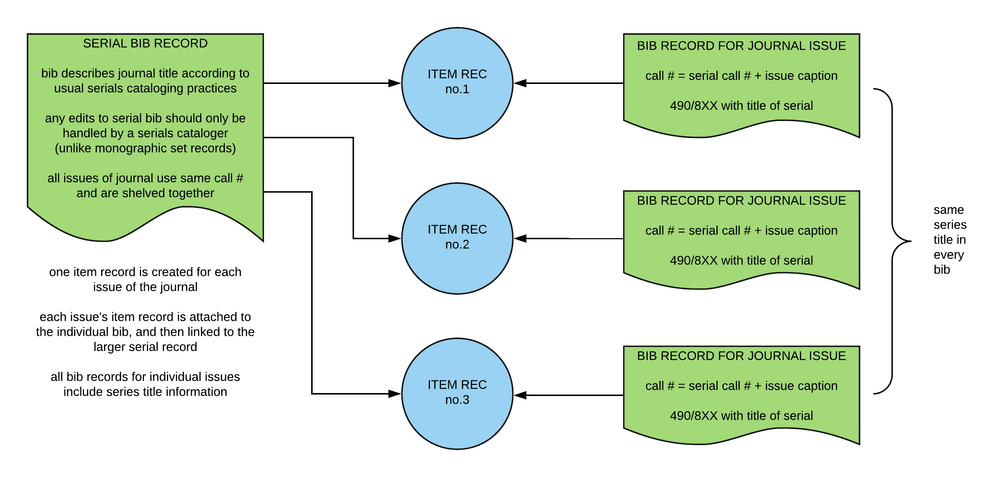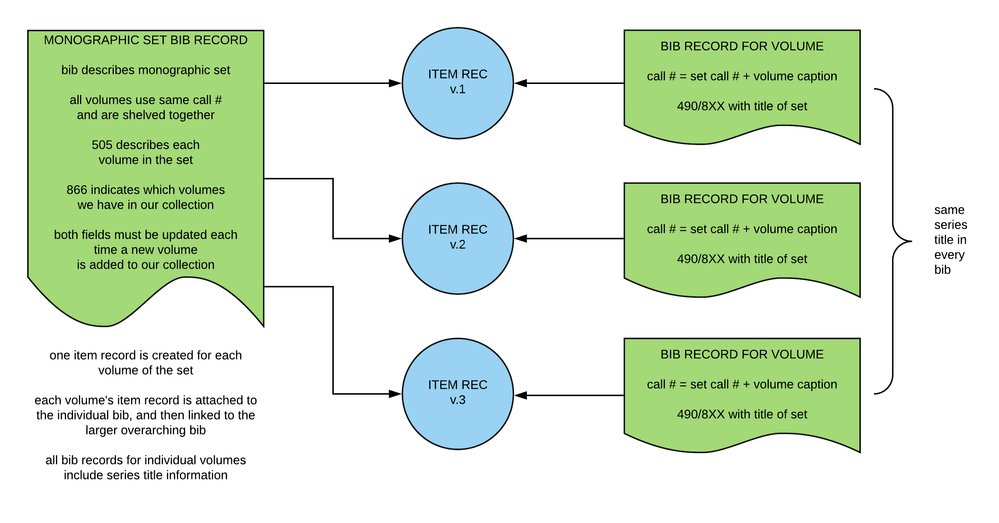Analytics
Summary: Instructions for cataloging works that belong to a larger work but are also described at the unit level.
General info
These materials are called analytics because each unit of a larger overarching work is "analyzed" – i.e., given individual description and subject analysis, in addition to its inclusion as a unit in the larger work's description. Linking work is done in the catalog to maintain connections between the larger work's bib record and the individual bib records for the analyzed parts.
To compare set and serial analytics with other types of multipart works, visit the Multipart works explained page.
There are two basic types of analytics:
(1) Serial analytics are issues of a serial title that are added as items to the overarching serial bib record, but are also given monographic cataloging treatment at the issue level. Each record for an issue includes a series title (usually the title of the overarching serial) with appropriate series numbering.

(2) Set analytics are volumes of a monographic set that are added as items to the overarching monographic set bib record, but are also given monographic cataloging treatment at the individual volume level. Each record for a volume includes a series title (usually the title of the overarching set) with appropriate series numbering.

In general, for both set and serial analytics, the bib record for the larger work is set up on a standing order and will have a check-in record. But the cataloger only needs to concern themselves with new bib and item record creation for the appropriate unit parts being cataloged.
Multivolume sets within serial or set analytics
In either case of analytic cataloging, it is possible the cataloger will be describing a sub-set within the larger work. In other words, instead of analytic treatment of one individual volume or serial issue, the cataloger will perform analytic treatment for a multi-volume set. Here is a visual example of analytic cataloging of a multi-volume set within a larger monographic set:
.png?version=1&modificationDate=1564671100834&cacheVersion=1&api=v2&width=1000&height=598)
An analyzed multi-volume set within a serial would look similar, with just a few small logistical differences. Series tracing and captioning for sub-sets within larger multipart works involves some extra consideration. See the instructions below for more details.
Set analytics
This term applies to single volumes of a larger overarching monographic set which receive analytic treatment. Volumes to be added to monographic set analytics are placed on the analytics shelf near Kay's office, and generally contain a Serials Acquisitions streamer with the Set Analyze instruction, the call number of the larger work bib, and location info.
1. Edit the overarching monographic set bib
Using the provided call number, locate the larger set's bib record in Sierra.
- Make additions for your volume to the 505 and 866 fields as appropriate.
- Note the bib record number (you will want it for linking in Sierra).
See the procedures for cataloging a normal monographic set for additional details about adding items to set records.
2. Perform individual monographic cataloging on the volume
- Find or create a bibliographic record specific to your volume
- The bib record should include:
- Call number from the overarching work's bib + the volume caption
- Example:
- Overarching work's call number is BS192.2.A1 2008|bG3
- Individual volume call number in the 050/090 would be BS192.2.A1 2008|bG3 v.32
- The appropriate call number is also usually already indicated for you on the streamer
- Example:
- 490/8XX pair containing title of the overarching work
- Call number from the overarching work's bib + the volume caption
- Ensure the item record for your volume contains the appropriate fields:
- sublocation
- v field with appropriate volume caption
- w field with analytic workstat: xxxanalyticxxx
- Ensure the full call number with caption is c-tagged in your new bib record in Sierra
3. Perform Sierra linking functions
- In individual bib, go to Summary view
- Select item you created for your volume
- Edit → Link to additional bib record → Find bib
- Locate the overarching work bib using the record number
- Click "Use bibliographic record"
- Move your item record to the correct numerical/chronological position in the list of item records.
Once the linking is performed, the bib record for the individual volume will repeat the volume caption in the OPAC's public display. This is a quirk of analytic cataloging that can't be avoided and should not worry the cataloger.
Serial analytics
This term refers to single issues or volumes of a larger overarching serial title which receive analytic treatment. The process for cataloging serial analytics is almost the same as the monographic set analytic procedure above. However, editing or changing the bib record of an overarching serial work can only be done by trained serials catalogers.
In general, when performing individual cataloging of an issue, do not overlay on a purchase order number; instead, if the piece is acquired as a firm order or via approval plan, do some maintenance/merging in Sierra as needed after export.
- Make appropriate edits to the overarching serial bib record, in keeping with serials cataloging guidelines.
- for titles not on standing order, the cataloger is responsible for holdings in the check-in record and OCLC LHR
- for standing order titles, the cataloger not responsible for maintaining holdings info
- watch for series title changes → bump to Lyudmila (who can perform maintenance on the standing order)
- Follow Steps 2-3 above.
Analyzed sub-sets
Sometimes, multi-volume sub-sets can occur within an overarching serial or monographic set work. Analytic cataloging of these sub-sets requires a few extra considerations.
1. Edit the overarching serial or monographic set bib
- Overarching work is a serial
- Follow the general guidelines for editing & adding volumes to a serial record. More information is available in our serials documentation.
- Follow the general guidelines for editing & adding volumes to a serial record. More information is available in our serials documentation.
- Overarching work is a monographic set:
- Using the provided call number, locate the larger set's bib record in Sierra.
- Make additions for your volume to the 505 and 866 fields as appropriate.
- If two numbering systems are in use (one for the larger overarching set, one for the sub-set), use the captioning for the larger overarching set only, unless you feel patrons need more granular information. Remember the sub-set's numbering will be reflected in the sub-set bib record.
- Note the bib record number (you will want it for linking in Sierra).
- See the procedures for cataloging a normal monographic set for additional details about adding items to set records.
2. Perform individual monographic cataloging on the sub-set
- Find or create a bibliographic record specific to your multi-volume set, following procedures for cataloging monographic sets.
- Determine numbering of your sub-set – consecutive or non-consecutive?
- Consecutive example: sub-set is volume 45, 46, and 47 of the larger overarching work
- Non-consecutive example: sub-set is volume 42, 45, and 48 of the larger overarching work
- Consecutive numbering – bib should include:
- Call number of the overarching work bib + volumes/issues of the overarching work
- Example:
- Overarching work's call number is BS192.2.A1 2008|bG3
- Sub-set is volumes 45-47 of the overarching work
- Individual volume call number in the 050/090 would be BS192.2.A1 2008|bG3 v.45-47
- Ensure the full call number with caption is c-tagged in your new bib record in Sierra
- Example:
- 505 contents field with titles of sub-set volumes, if applicable
- If the sub-set uses its own numbering system, use them here, along with parallel numbers from overarching set
- Example: T.1=v.45. Volume title. t.2=v.46. Volume title. t.3=v.47. Volume title.
- 490/8XX pair containing title of the overarching work
- Use range of volumes in $v field of both
- Example:
- 490 1_ |a Overarching work title ; |v 45-47
- 830 _0 |a Overarching work title ; |v 45-47
- 866 field indicating which volumes of the sub-set we have in our collection
- If the sub-set uses its own numbering system, use them here, along with parallel numbers from overarching work
- Example: t.1-3=v.45-47
- Item records for each volume in the sub-set
- sublocation
- c field with overarching work's base call number + volume or issue caption
- v field with overarching work's volume or issue caption
- w field with analytic workstat: xxxanalyticxxx
- Call number of the overarching work bib + volumes/issues of the overarching work
- Non-consecutive numbering – bib should include:
- Call number of the overarching work bib + 1st volume/issue
- Example:
- Overarching work's call number is BS192.2.A1 2008|bG3
- Sub-set is volumes 42, 45, and 48 of the larger overarching work
- Individual volume call number in the 050/090 would be BS192.2.A1 2008|bG3 v.42
- NOTE: If the sub-set is also shared with LoM or Law, use the older practice of adding "etc."
- Example: BS192.2.A1 2008|bG3 v.42, etc.
- Ensure the full call number with caption is c-tagged in your new bib record in Sierra
- Example:
- 505 contents field with titles of sub-set volumes, if applicable
- If the sub-set uses its own numbering system, use them here, along with parallel numbers from overarching work
- Example: T.1=v.42. Volume title. t.2=v.45. Volume title. t.3=v.48. Volume title.
- one 490 for all volumes and one 8XX for each volume, containing title of the overarching work
- Example:
- 490 1_ |a Overarching work title ; |v 42, 45, 48
- 830 _0 |a Overarching work title ; |v 42
- 830 _0 |a Overarching work title ; |v 45
- 830 _0 |a Overarching work title ; |v 48
- Example:
- 866 field indicating which volumes of the sub-set we have in our collection
- If the sub-set uses its own numbering system, use them here, along with parallel numbers from overarching work
- Example: t.1=v.42,t.2=v.45,t.3=v.48
- Item records for each volume in the sub-set
- sublocation
- v field with overarching work's volume or issue caption
- w field with analytic workstat: xxxanalyticxxx
- Call number of the overarching work bib + 1st volume/issue
3. Perform Sierra linking functions
- In sub-set bib, go to Summary view
- Select all item records you created for each volume of the sub-set
- Edit → Link to additional bib record → Find bib
- Locate the overarching work bib using the record number
- Click "Use bibliographic record"
- Move your item records to the correct numerical/chronological position in the list of item records.
| Contact | Autumn Faulkner |
| Team | CMS |
| Updated | August 2019 |
| Created | August 2018 |